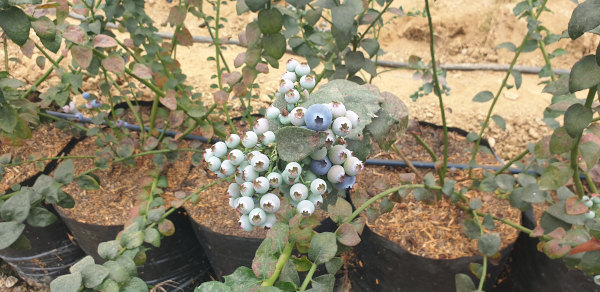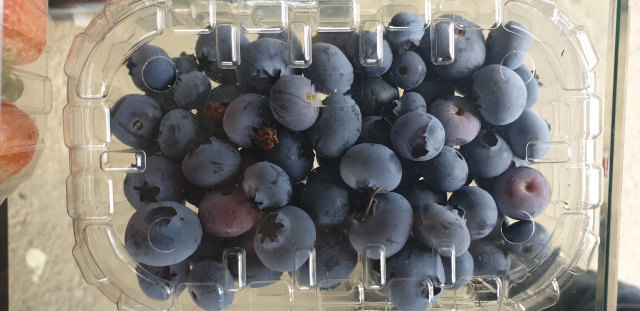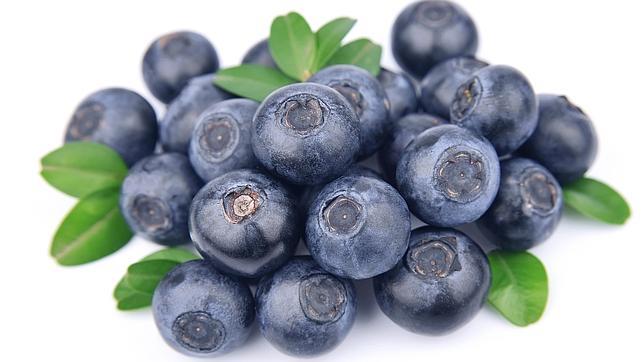Blueberries (Blueberries) hydroponic and enriched with Ozone

History
As for the history of the blueberry bush, it must be said that it is an herb that has been part of the Nordic culture, including the North Pole culture, for millennia. In fact, so much so that he has been part of his diet forever.
The fruits, which are born in clusters, are white at first and as they ripen they turn reddish-purple to become blue when they are fully ripe. For their sweet taste they are used to make jellies, jams, wines, cakes and various sweet dishes.

This species is native to the United States, which is also the largest producer and consumer of blueberries in the world.
The fruits of wild plants, smaller and more expensive than those grown, are appreciated for their flavor and intense color
Plant |
Small shrub 0.2-0.4 meters high, whose scientific name is Vaccinium sp., Belonging to the Ericaceae family. |
Nutrition |
Each 1/2 cup serving of fresh blueberries contains 11 g of carbohydrates from two main sources: dietary fiber and simple sugars. A serving of blueberries contains 10 percent of the daily requirements for vitamin C, as well as 2 percent of the recommended daily amount of iron. Vitamin C helps in the formation of collagen, helps maintain healthy gums and capillaries, and promotes iron absorption and a healthy immune system. |
Source Rich in Antioxidants |
Antioxidants are compounds that fight important diseases. Scientists believe that they help prevent and repair the stress that comes from oxidation, a natural process that occurs during normal cell function. A small percentage of cells are damaged during oxidation and become free radicals, which can initiate a chain reaction to damage more cells and possibly disease. The antioxidant and anti-inflammatory properties of blueberries benefit the health of the heart and protect it. Recent studies conducted by Dr. Xanli Wu and his colleagues at the Arkansas Children's Nutrition Center in Little Rock, focused on inflammation and atherosclerosis. Cranberries have also been shown to protect against cardiovascular disease, reduce cholesterol, blood pressure, protection against stroke and reduce oxidative stress. They also prevent suffering from heart attacks. |
Keeps your brain healthy |
Eating blueberries can help you keep your brain in good condition, even entering old age. Cranberries contain flavonoids that enhance your memory and improve learning and other cognitive functions. They protect your brain from free radicals that can be harmful to you since they can damage healthy tissue and are generally related to memory loss. Blueberries can also help reduce the risk of having Parkinson's or Alzheimer's. It is recommended to consume a cup of blueberries every day. |
Improve the function of your memory |
An injection of nutrients that protect long-term memory |
Defer the effects of old age |
Daily consumption of modest amounts of blueberries dramatically reduces memory deficits and motor coordination that normally accompany aging. |
How to drink |
Blueberries can be consumed in a number of ways: fresh, frozen, dried, concentrated powder, tea, juice and extract. The most common way to consume blueberries is in its fresh, whole form. While the best berries are eaten fresh seasonally, new and interesting studies show that the freezing of blueberries does not harm their delicate anthocyanin antioxidants, making them a year-round source. |
MORE MEDICINAL BENEFITS
- As its calorie content is very low, it is very important in diets, they reduce blood sugar
- It has anti-inflammatory properties. More than 30 anti-inflammatory properties are present in blueberries and can help reduce the effects of inflammatory bowel disease.
- They cure oral inflammations (leaving them to macerate and preparing a gargle) due to their disinfectant properties;
- Dry fight diarrhea and fresh have laxative properties: Astringent agents are able to stop diarrhea and aid digestion difficult.
- It has the quality of reducing cholesterol.
- Sight improvement Cranberries stand out for their vitamin A content, which are essential to achieve a better state of sight. . They are also used to improve myopia ....
- Against urinary infection ...
- It delays the aging phase. ...
- Berries and leaves have a number of medicinal properties that have been used for generations to treat and prevent digestive orders.
- Strengthen the defenses
- Improve circulation, decrease the risk of cardiovascular disease
- Decreases the risk of neurological diseases such as Alzheimer's disease. Blueberries are also brain stimulants. Studies have shown that blueberries can help with memory loss and increased circulation, which can help fight the onset or progression of degenerative diseases such as Parkinson's and Alzheimer's. The findings have stimulated new research on the benefits of blueberries in cognitive function, as they point to the possibility of overcoming genetic predispositions to Alzheimer's disease.
- It lowers the risk of high cholesterol and cancer.
- Blueberries have one of the highest antioxidant abilities of all fruits and vegetables, which fights free radicals that can damage cell structures and DNA.
- They have been used for the treatment of diseases of the urinary tract. Studies have shown that the hippuric acid in blueberry juice acidifies the urine, which prevents harmful bacteria from developing and helps eliminate calcium oxalates that lead to kidney stones.
- Tea made from dried leaves can be used for sore throat and inflammation of the mouth or skin that lines the throat.
OTHER CULINARY APPLICATIONS
In the canning industry it has an increasingly important role, its transformation into jam, as well as an ingredient in alcoholic beverages and especially as a dye. Due to the juice of its pulp, it is accompanied very well in game dishes, in the preparation of cooking sauces or as a garnish for meat and fish. The fruit can be transformed into jellies and jams, being filled with cakes and pies.

